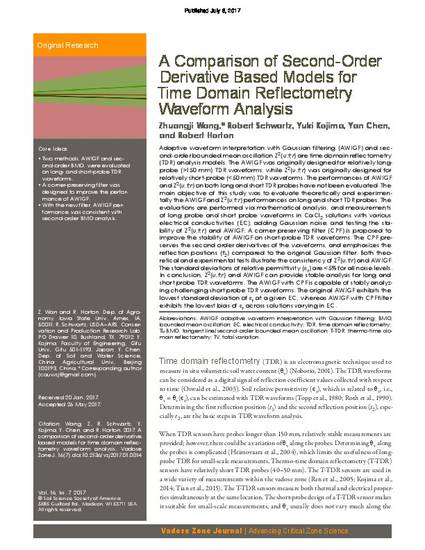
Core Ideas
- Two methods, AWIGF and second‐order BMO, were evaluated on long‐ and short‐probe TDR waveforms.
- A corner‐preserving filter was designed to improve the performance of AWIGF.
- With the new filter, AWIGF performance was consistent with second‐order BMO analysis.
Adaptive waveform interpretation with Gaussian filtering (AWIGF) and second‐order bounded mean oscillation Z2(u,t,r) are time domain reflectometry (TDR) analysis models. The AWIGF was originally designed for relatively long‐probe (>150 mm) TDR waveforms, while Z2(u,t,r) was originally designed for relatively short‐probe (<50 mm) TDR waveforms. The performances of AWIGF and Z2(u,t,r) on both long and short TDR probes have not been evaluated. The main objective of this study was to evaluate theoretically and experimentally the AWIGF and Z2(u,t,r) performances on long and short TDR probes. The evaluations are performed via mathematical analysis, and measurements of long probe and short probe waveforms in CaCl2 solutions with various electrical conductivities (EC), adding Gaussian noise, and testing the stability of Z2(u,t,r) and AWIGF. A corner‐preserving filter (CPF) is proposed to improve the stability of AWIGF on short‐probe TDR waveforms. The CPF preserves the second order derivatives of the waveforms, and emphasizes the reflection positions (t2) compared to the original Gaussian filter. Both theoretical and experimental tests illustrate the consistency of Z2(u,t,r) and AWIGF. The standard deviations of relative permittivity (εr) are <5% for all noise levels. In conclusion, Z2(u,t,r) and AWIGF can provide stable analysis for long and short probe TDR waveforms. The AWIGF with CPF is capable of stably analyzing challenging short probe TDR waveforms. The original AWIGF exhibits the lowest standard deviation of εr at a given EC, whereas AWIGF with CPF filter exhibits the lowest bias of εr across solutions varying in EC.
Available at: http://works.bepress.com/robert-horton/146/

This article is published as Wang, Zhuangji, Robert Schwartz, Yuki Kojima, Yan Chen, and Robert Horton. "A Comparison of Second‐Order Derivative Based Models for Time Domain Reflectometry Waveform Analysis." Vadose Zone Journal 16, no. 7 (2017): 1-10. doi: 10.2136/vzj2017.01.0014.